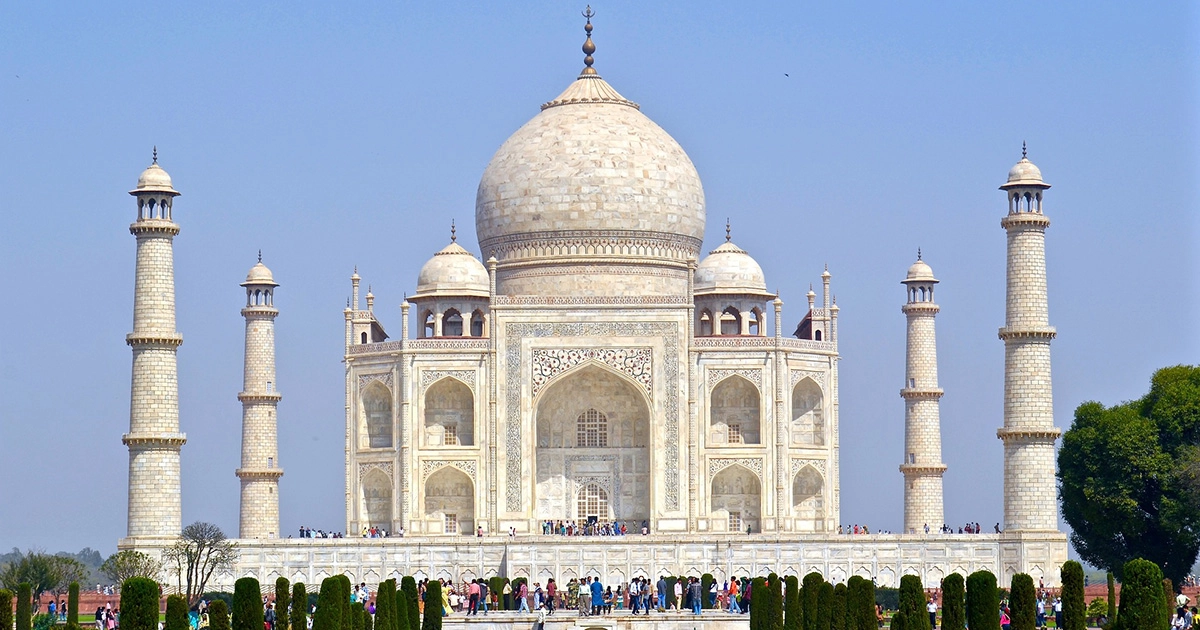India
India is one of the most vibrant, distinctive, controversial and attractive countries in the world. This is the birthplace of Hinduism, where many people come to rethink their lives, find peace and harmony. The state is located in South Asia, on the Hindustan Peninsula. India is a republican state that is an influential player on the world stage.
The official name of the state is the Republic of India. The country covers 3,287,263 km², making it the largest country in South Asia. For a long time, India was the most populous country in the world. Now the country has been overtaken by China, but the number of people living in India is still impressive — 1.4 billion people. The Constitution of India defines 21 official languages. The national religion of India is Hinduism, which is practiced by about 80% of the population. The territory of the country is divided into 28 states and 8 union territories. The national currency is the Indian rupee.
The capital is located in New Delhi, however, by the standards of India it is a miniature city with a population of only 3 million people. The location of the capital in such a small subject is explained by the historical origins of the center of the country. The largest cities of the state are Mumbai, Bangalore, Delhi, Hyderabad and Chennai. For most of its history, India has been the center of important trade routes and has been renowned for its riches and high culture. India is also a space power and a potential superpower.
For Europeans, India has always been a rich and attractive region. The European nobility was willing to pay huge sums of money for Indian spices, fabrics and jewelry. The struggle for India began in the 16th century, when the first Portuguese colony appeared on Hindustan. Soon rivalry for Indian wealth and domestic markets unfolded between Portugal, Spain, France, England and the Netherlands. In 1856, the British conquerors established their power in the state. Today, India's economy can be described as a mixed one. Thanks to the talented leaders of the country, such as Indira Gandhi, Lal Bahadur Shastri and Narasimha Rao, a number of successful economic reforms and many technological innovations have been introduced here. Today, due to the cheapness of manual labor and raw materials, there are branches of many large European and American industrial enterprises in India. But, despite high GDP, exports and the constant development of domestic business, most Indians live below the poverty line. This phenomenon is explained by some features of the mentality, and religious and philosophical attitudes.
India borders Pakistan to the west, China, Nepal and Bhutan to the northeast, and Myanmar and Bangladesh to the east. In the south, India is washed by the Indian Ocean, in the southwest — by the Arabian Sea. The Bay of Bengal is located in the southwest of the country. The total length of the state border is 15,106 km. India owns several islands. The largest of them are the Laccadive, Andaman and Nicobar Islands in the Indian Ocean. Due to the near-mountain location and the proximity of the ocean, the climatic conditions are very diverse — from the extremely cold regions of the Himalayas to the humid tropical regions of the south. There are 3 seasons and 5 climatic regions in the country. Transport in India is well developed, you can get almost anywhere in the country.
India is a country with a huge cultural heritage. Indian culture has influenced not only neighboring countries, but also other states located far from it. Until now, India has a caste system of society, thanks to which Indian culture retains all its traditional values. In addition, Indian cuisine is very popular. It is known all over the world for its abundance of spices. It is thanks to the Indians that various seasonings, including black pepper and curry, have become widespread in the world. Education in most universities in India is conducted in English. Higher education in the country is provided at the level of programs of European universities.
Indians are completely non-conflict, especially in dealing with foreigners. They do not differ in touchiness and willingly make contact — it will not be difficult to find out the way or where to buy something. This is a rather emotional nation, which is not inherent in shyness. Dances and songs are also a striking feature of the Hindus. Artistry is also inherent in the inhabitants of India — among them there are often wonderful storytellers who are able to present even the most ordinary story in bright colors. In addition, Indians are excellent traders. Their boundless bazaars and markets cannot but attract with their abundance. Despite the difficult life, many people know how to sincerely rejoice in its good moments.
The Constitution of India was adopted by the Constituent Assembly at the end of 1949, two years after India's independence. It is the largest constitution in the world. In the preamble to the constitution, India is defined as a sovereign, socialist, secular liberal democratic republic. State power is divided into three branches: legislative, executive and judicial. The head of state is the President of India, who is elected for 5 years. The head of government is the prime minister. The main political parties in India are the Indian National Congress, the Bharatiya Janata Party, the Socialist Party, the Communist Party of India, the National People's Party, and others.
India maintains friendly relations with most countries. In recent years, India has continued to play a prominent role in the Association of Southeast Asian Nations, the South Asian Association for Regional Cooperation and the World Trade Organization. India is one of the founding members of the United Nations and an active participant in its peacekeeping missions. Recently, in the foreign policy arena, the Indian government has directed efforts to improve relations with the United States, China and Pakistan. In the economic sphere, India has close relationships with other developing countries in South America, Asia, and Africa.
For much of its post-independence history, India has pursued a socialist economic policy with government involvement in the private sector, strict controls on foreign trade and investment. Since 1991, the country has begun liberal economic reforms, opening up its market and reducing government control over the economy.
The Indian economy is one of the fastest growing in the world. The labor force in India is approximately 521.9 million people: 47% of the employed work in agriculture; 31% -— in the field of services; and 22% in industry. The main crops are rice, wheat, cotton, jute, tea, sugar cane and potatoes. Main Industries: Automotive, Chemical, Cement, Consumer Electronics, Mechanical Engineering, Mining, Petroleum, Pharmaceutical, Metalworking, Food and Textile.
Over the past two decades, the Indian economy has experienced steady growth, but when comparing different social groups, geographical regions, rural and urban areas, economic growth has not been uniform. Despite notable economic progress, a quarter of the country's population lives below the state-established subsistence level.
Recently, India, thanks to the presence of a large number of English-speaking professionals, has become an outsourcing destination for many multinational corporations and a popular destination for "medical tourism". India has also become a significant exporter of software, as well as financial and technology services. India's main natural resources are arable land, bauxite, chromite, coal, diamonds, iron ore, limestone, manganese, micas, natural gas, oil and titanium ores. India's main trading partners are the United States, the European Union and China.
The government of Narendra Modi, who came to power, began to actively implement a whole range of measures and programs aimed at stimulating the country's economic development. The measures being implemented, among other things, relate to the improvement of public administration, improvement of the business and investment climate in the country.
As part of the implementation of a new large-scale initiative of the Government of India "Make in India", aimed at developing the country's production potential, a "one-stop shop" system has been introduced for coordinating projects. Foreign investors have been able to invest in such important sectors of the Indian economy as the military-industrial complex, railways and insurance. An important achievement was the unprecedented increase in the availability of banking services for the rural and poor population. Approximately 125 million new bank accounts were opened for the direct transfer of subsidies (for the consumption of kerosene, fertilizers, food subsidies, etc.).
The most promising sectors are energy (including nuclear), mining, metallurgical, chemical and petrochemical industries, civil aviation, construction of infrastructure facilities, pharmaceuticals, information and telecommunication technologies. India has a huge mass of skilled and relatively cheap labor, which makes it possible for a company to grow from scratch.
Today, India is in the top 100 countries for ease of doing business. The inflow of foreign direct investment into India is constantly increasing. The implementation of a set of measures to improve the investment climate is the most important condition for maintaining the country's competitiveness in attracting FDI. The country ranks highly among FDI recipients, but the level of competition for foreign investment is also high.
The investment potential of India is very high. The advantages of this country are: human factors; production factor; the presence of competition; consumer market; availability of various infrastructures; the legislative framework; political stability of the state; the presence of a government that aims to attract long-term investment; the presence of bodies that monitor compliance with the law and exercise control over the fulfillment of all obligations; the stability of the country's currency.
Over the past few years, India has undergone major changes in the organization of state support for small and medium enterprises. The two previously existing SME support ministries have been merged into one Ministry of Small and Medium Enterprises (MSME), which coordinates a strong and extensive support infrastructure with branches in all major cities. There are currently 30 SME service institutes in the country with 248 branches.
Progress in the development of small innovative entrepreneurship is largely determined by the policy of the Government of India. The main task of the government is to strengthen the competitiveness of the national SME sector, with particular attention being paid to supporting innovation in export orientation.
In addition to ministries, NSIC Corporation actively assists small businesses in promoting their products and services to the market through the organization of special exhibitions. During such exhibitions, interaction is established between entrepreneurs looking for new technologies and their sellers. The issues of technology transfer, the possibility of cooperation or interaction between businesses are discussed. NSIC Corporation plays a leading role in the industrial development of the interior and other regions of the country.


105,150,952 ¥

122,654,057 ¥
9,805,789 ¥
179,772,769 ¥










